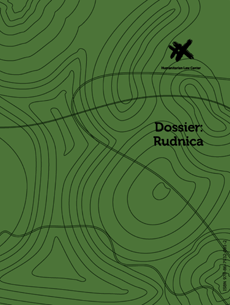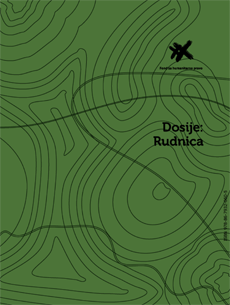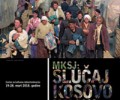Dossier: Rudnica
 At the time of the publication of this Dossier (January 2015), the mortal remains of 52 people were exhumed from Rudnica and identified. DNA analysis conducted on the remains has shown that they belong to Kosovo Albanians killed during the Kosovo conflict in 1999. According to a representative of the Commission on Missing Persons of the Government of the Republic of Serbia, search of the Rudnica site will continue if the relevant institutions come up with new data.
At the time of the publication of this Dossier (January 2015), the mortal remains of 52 people were exhumed from Rudnica and identified. DNA analysis conducted on the remains has shown that they belong to Kosovo Albanians killed during the Kosovo conflict in 1999. According to a representative of the Commission on Missing Persons of the Government of the Republic of Serbia, search of the Rudnica site will continue if the relevant institutions come up with new data.
Information about the existence of the grave was disclosed by a Kosovo Albanian during the investigation into the “Drenica Group” case, which was conducted before the District Court in Mitrovicë/Mitrovica. Relevant institutions have searched this location on several occasions since 2007, and the first human remains were exhumed in 2013.
The mass grave in Rudnica is located right next to a lot of land that has been used by the VJ since an undetermined date before 1999. The VJ built a barracks over it, which, according to the Ministry of Defence, was put into operation in 2002 and then in 2006 handed over to the MUP.
All persons whose bodies were found in Rudnica were civilians who had been killed or forcibly disappeared in four separate crimes committed by members of the VJ and MUP in April and May 1999 in the Drenica area (area in central Kosovo covering the municipalities of Skënderaj/Srbica and Gllogoc/Glogovac). On the basis of the analysis of available data, the Dossier describes in great detail the four crimes in which the civilians whose bodies were found in Rudnica had been killed. Two military-police actions, carried out in Rezallë/Rezala and Çikatovë e Vjeter/Staro Čikatovo, in the course of which two mass crimes were committed, have been reconstructed to a large extent. At least 68 civilians were killed in these actions, of which 47 were found in Rudnica. In connection with the forcible disappearance, that is the killing of five civilians in Zabel i Ulët/Donji Zabelj and Gllanasellë/ Gladno Selo, documents were provided that indicate the presence of certain military and police units in the villages at the time these crimes were committed.
The bodies of 10 persons killed in the crime in Rezallë/Rezala on April 5th 1999 have not yet been found.
The villages where the crimes against the victims whose bodies were hidden in Rudnica took place were at the relevant time in the zone of responsibility of the Yugoslav Army’s 37th Motorized Brigade (37th mtbr). During this period, several actions were carried out under the command of the 37th mtbr, in which military as well as police units took part. According to military documents, their task was to “destroy SHTF” [“Shiptar terrorist forces” – author’s note]. The 37th mtbr had its home barracks in Raška, had 4,500 members and was equipped with infantry and artillery weapons and tanks.
Analyses of military and police documents, eyewitness accounts and other sources strongly suggest that the crimes in Rezallë/Rezala and Çikatovë e Vjeter/Staro Čikatovo were committed by members of the 37th mtbr, as part of the “SHTF destruction” actions. Besides the 37th mtbr, the involvement of an as-yet-unidentified police unit in the crime in Rezallë/Rezala was also documented, while in Çikatovë e Vjeter/Staro Čikatovo, a smaller formation of the VJ’s 15th Armoured Brigade (15th okbr) and the 86th detachment of the Special Police Units (PJP) were present at the time. Eyewitnesses and survivors of the crime in Çikatovë e Vjeter/Staro Čikatovo and Rezallë/Rezala recognized the military uniforms worn by the members of the Serbian forces who were involved in these crimes.
Based on the available sources, it is not possible to determine with certainty which military unit was responsible for the forcible disappearance of four civilians from the village of Zabel and Ulët/Donji Zabelj. From the testimony of several eyewitnesses, it can be concluded that it was members of the military police. However, military documents point to the presence of the 37th mtbr and the 15th okbr in and around Zabel i Ulët/Donji Zabelj at the relevant time. According to eyewitness accounts, Rrahman Nika was killed by members of the VJ in Gllanasellë/Gladno Selo. According to documents of the Third Army, a substantial part of the 37th mtbr forces were deployed in and around Gllanasellë/ Gladno Selo on the day in question.
As for the removal of the bodies of those killed and their transfer to Rudnica, only some of the events and actions of representatives of the institutions of the former Federal Republic of Yugoslavia and the Republic of Serbia that led to the concealment of the bodies in Rudnica have so far been reconstructed. More specifically, the Dossier has identified only the initial link in the chain of institutions that took part in the removal of the bodies of the murdered civilians.
The so-called ‘clearing up of the battlefield’ in the area of Rezallë/Rezala, Çikatovë e Vjeter/Staro Čikatovo, Zabel i Ulët/Donji Zabelj and Gllanasellë/Gladno Selo was the responsibility of the 37th mtbr. There is irrefutable evidence indicating that the brigade’s Squad for clearing up of the battlefield had first-hand knowledge of the bodies of people killed in Rezallë/Rezala and informed the brigade Command of this. Military documents indicate that the 37th mtbr was responsible also for the clearing up of the battlefield following other crimes in these villages that are described in this Dossier.
According to international law and the instructions given by the Priština Corps at the relevant time, the clearing up of the battlefield involved an extensive procedure entailing identification, burying and making lists of the bodies found, that was carried out together with the civilian authorities. Also, the applicable regulations required the notification of military investigative bodies of any indications that crimes had been committed. However, the available documents and the very fact that the bodies remained hidden in a secret location for 15 years conclusively prove that the bodies of the victims from Rezallë/Rezala, Çikatovë e Vjeter/Staro Čikatovo, Zabel i Ulët/Donji Zabelj and Gllanasellë/ Gladno Selo were treated in a manner contrary to the rules of international law.
It should be noted that the Ministry of Defence has denied the HLC access to several documents that are not available in the ICTY Judicial Database, justifying it by stating, among other things, that providing access to the requested documents would be detrimental to the operational and functional capability of the Serbian Army (VS). The requested documents would greatly contribute to a more complete reconstruction of the events depicted in the Dossier.
During the analysis of the material compiled while writing the Dossier, a large number of individuals were identified who at the very least “knew or had reason to know” that crimes had been committed in the aforementioned villages, as well as individuals who ordered and carried out the removal of the bodies. Most of them are former members of the 37th mtbr, including its then commander and the incumbent Chief of General Staff of the VS, Ljubiša Diković. Finding out what they know about the crimes, along with the examination of witnesses and of the documents the HLC has managed to obtain – and of those stored in the VS archive which the HLC could not obtain – are the first and key steps to an independent and comprehensive investigation aimed at identifying those responsible for the killings in Rezallë/Rezala, Çikatovë e Vjeter/Staro Čikatovo, Zabel i Ulët/Donji Zabelj and Gllanasellë/Gladno Selo, and for keeping the bodies of the victims hidden for 15 years.
You can download the Dossier here.









